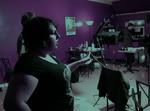Filed under:
1) Bodenstedt, Lisa, and Remington, R. Roger. American Modernism: Graphic Design, 1920-1960. Connecticut; Yale University Press, 2003.
This book discussed American modernism in graphic design. It discussed the tension facing artists who also work in design and whether or not that is art.
2) Soby, James Thrall. Ben Shahn: His Graphic Art. New York: George Braziller, INC, 1957.
This book discussed Ben Shahn’s personal and professional life, it also had a lot of his artwork.
3) Toogood, Alex F. “A Framework for the Exploration of Video As a Unique Art Form.” Journal of the University Film Association 30.2 (1978): 15-20.
This article discusses how the technological aspects of video and film are very different and how that leads to both being distinct art forms.
4) Drucker Johanna, and McVarish, Emily. Graphic Design History: A Critical Guide. New Jersey: Pearson Education, 2009.
This book discussed the history of graphic design. I specifically benefited from the chapter on 1950s, it talked about business design and logotypes.
5) Zettl, Herbert. “The Rare Case of Television Aesthetics.” Journal of the University Film Association 30.2 (1978): 3-8.
This article discusses how television has been overlooked aesthetically due to snobbery and the misunderstanding of the medium. Then the article discusses how physical characteristics of television effect it aesthetically, like light and sound.
6) Baughman, James L. Same Time Same Station. Baltimore: The Johns Hopkins University Press, 2007.
This book has instilled in me a vast knowledge of the first couple decades of television production. It was very thorough and covered most historical aspects of early television. It talked in great detail about the difference between the major networks, first CBS and NBC and later ABC and how they compared as far as business strategy.
7) Tucker, Patrick. The Secrets of Screen Acting. New York and London: Routledge, 2003.
This book discussed the vast difference between screen and stage acting. It showed me that acting for each is a different craft.
![]() Metallinos, Nikos. Television Aesthetics. Mahwah, New Jersey: Lawrence Erlbaum Associates, Publishers, 1996.
Metallinos, Nikos. Television Aesthetics. Mahwah, New Jersey: Lawrence Erlbaum Associates, Publishers, 1996.
This book discusses aesthetics in terms of psychology and research. I appreciated the discussion on how fine arts effect our perception of television.
9) David Thorburn. “Television as an Aesthetic Medium.” Critical Studies in Mass Communications. 4.2 (1987) 161-173.
This article discusses how looking at the aesthetics of television as an anthropological study gives us insight into societies beliefs and structures.
10) Spigel, Lynn. TV by Design. Chicago: University of Chicago Press, 2008.
This book gave me insight into the complex relationship between modern art and television. I found the chapter “An Eye for Design” to be particularly relevant to my research report because it drew a correlation between business image and modern design.
11) Newcomb, Horace. TV the Most Popular Art Form. New York: Anchor Press, 1974.
This book talks about how we need to understand form and be able to manipulate it, to better complement the content and make media more effective in that way.
12) Newcomb, Horace. “Toward a Television Aesthetic.” Television: The Critical View. Ed. Horace, Newcomb. New York: Oxford University Press, 1987. 613-627.
This article discussed how the physical elements limiting television have helped it develop a specific aesthetic, for example the smallness of television screen creates an immediate intimacy between the program and the viewer.
13) Newcomb, Horace. “Toward the Television History: The Growth of Styles.” Journal of the University Film Association 30.2 (1978): 9-14.
This article discusses the art of television as being a constantly moving and transforming thing.
14) Berger, John. Ways of Seeing. London: Penguin Books, 1972.
This book discussed how we view art, specifically oil paintings and class representations.
No Comments so far
Leave a comment
Line and paragraph breaks automatic, e-mail address never displayed, HTML allowed:
<a href="" title=""> <abbr title=""> <acronym title=""> <b> <blockquote cite=""> <cite> <code> <del datetime=""> <em> <i> <q cite=""> <strike> <strong>
